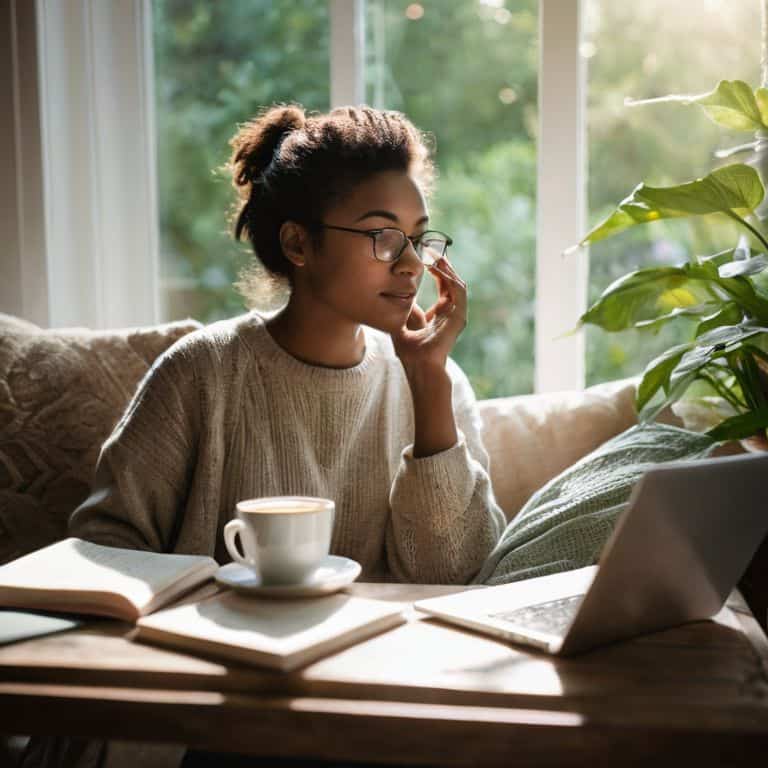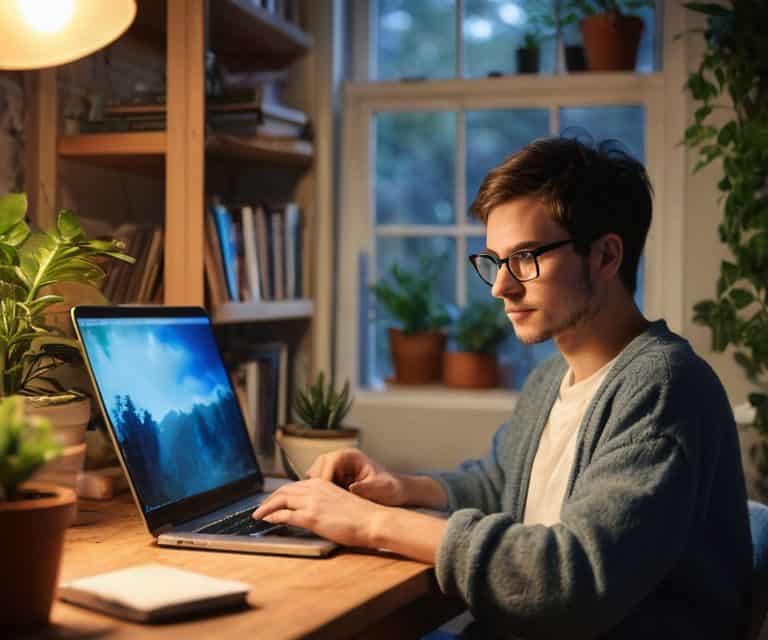I still remember the days when I spent hours staring at screens without a break, only to end up with severe eye strain and a throbbing headache. The common advice to take regular breaks didn’t quite cut it for me, and I found myself wondering if there was a better way to prevent eye strain from screens. As someone who’s experienced the burnout that comes from being “always on,” I’ve learned that it’s not just about taking breaks, but also about creating a sustainable routine that prioritizes eye health.
In this article, I’ll share my personal story and provide you with practical tips on how to prevent eye strain from screens. You’ll learn how to create a comfortable workspace, adjust your screen settings for optimal viewing, and develop healthy habits to reduce your risk of eye strain. I’ll cut through the noise and give you actionable advice that you can start implementing right away, so you can stay focused and productive without sacrificing your eye health. By the end of this article, you’ll have a clear plan to protect your eyes and maintain your overall well-being in a screen-dominated world.
Table of Contents
- Guide Overview: What You'll Need
- Step-by-Step Instructions
- Preventing Eye Strain From Screens
- Shielding Your Vision: 5 Practical Tips to Prevent Eye Strain from Screens
- Key Takeaways for a Healthier Digital Habits
- A Vision for Wellness
- Embracing a Healthier Relationship with Screens
- Frequently Asked Questions
Guide Overview: What You'll Need

Total Time: 30 minutes to 1 hour
Estimated Cost: $0 – $20
Difficulty Level: Easy
Tools Required
- Computer or mobile device (for adjusting display settings)
- Ruler or measuring tape (for measuring distance from screen)
- Blue light filtering glasses or screen protector (optional)
Supplies & Materials
- Good lighting for the room (to reduce glare)
- Comfortable seating and desk setup (to promote good posture)
- Screen cleaning kit (to keep screen free of dust and smudges)
Step-by-Step Instructions
- 1. First, let’s start with the basics: to prevent eye strain from screens, it’s essential to follow the 20-20-20 rule. This means that every 20 minutes, you should look away from your screen and focus on something 20 feet away for 20 seconds. This simple trick can help reduce the risk of eye strain and dry eyes.
- 2. Next, adjust the display settings on your devices to optimize the visual experience. This includes adjusting the brightness and contrast to comfortable levels, as well as tweaking the color temperature to reduce blue light emission, which can interfere with your sleep patterns. Many devices come with built-in features like Night Shift or Blue Light Filter, so be sure to explore these options.
- 3. Now, let’s talk about ergonomic positioning. When working on your computer or laptop, make sure the screen is directly in front of you, at a distance of about 20-25 inches, and the top of the monitor is at eye level or slightly below. This will help reduce strain on your eyes and neck. Additionally, consider investing in a document holder to keep your papers at eye level, reducing the need to constantly look down.
- 4. To further reduce eye strain, it’s crucial to blink regularly. When we’re focused on screens, we tend to blink less often, which can lead to dry, irritated eyes. Make a conscious effort to blink regularly, especially when working on complex tasks or watching videos. You can also try using artificial tears or eye drops to keep your eyes moisturized.
- 5. Another often-overlooked aspect of eye care is regular breaks. In addition to following the 20-20-20 rule, take longer breaks every hour to stand up, stretch, and move around. This will not only help your eyes but also reduce the risk of developing musculoskeletal disorders from prolonged sitting. Use this time to grab a snack, chat with a colleague, or simply take a few deep breaths.
- 6. Now, let’s discuss the importance of proper lighting in your workspace. Avoid placing your computer directly in front of a window, as this can create glare on the screen. Instead, position your computer in a way that the window is to the side, providing soft, natural light. If you’re working in a room with limited natural light, consider using a high-quality desk lamp to provide warm, gentle illumination.
- 7. Finally, make sure to get regular eye exams to monitor your eye health and address any underlying issues. Even if you don’t notice any problems, it’s essential to have your eyes checked by a professional every one to two years, depending on your age and risk factors. This will help you stay on top of your eye health and prevent potential problems from becoming more severe. By following these steps and prioritizing your eye care, you can reduce the risk of eye strain and maintain healthy, happy eyes.
Preventing Eye Strain From Screens

As someone who’s spent countless hours staring at screens, I can attest to the importance of taking care of our eyes. Digital eye fatigue symptoms can range from mild irritations to full-blown headaches, and it’s essential to take proactive steps to mitigate them. One simple yet effective way to do this is by setting screen time limits for adults. By establishing a daily limit and sticking to it, you can significantly reduce your risk of developing eye strain.
In addition to limiting screen time, there are several best eye exercises for computer users that can help alleviate eye fatigue. One of my favorites is the “blink exercise,” which involves consciously blinking every few seconds to keep your eyes moist and refreshed. I also recommend taking short breaks to gaze out the window and soak up some natural light benefits for eye health. Even a few minutes of natural light exposure can make a world of difference in reducing eye strain.
For those who spend extended periods gaming or working on computers, it’s crucial to invest in a good quality monitor with built-in gaming monitor eye care tips. Look for features like blue light filtering, adjustable brightness, and anti-glare coating to reduce eye strain. By combining these strategies with regular eye exercises and screen time limits, you can significantly reduce your risk of developing eye strain and maintain healthy, happy eyes for years to come.
Beyond Digital Eye Fatigue Symptoms
Beyond the obvious physical discomfort, digital eye fatigue can also affect our mental well-being. It’s not just about blurred vision or headaches; it’s about the emotional exhaustion that comes with staring at screens for hours on end. When we’re glued to our devices, we can feel disconnected from the world around us, leading to increased stress and anxiety. By taking breaks and prioritizing eye care, we’re not just saving our sight, we’re also safeguarding our mental health. This is why I emphasize the importance of scheduling rest time, just as you would any other non-negotiable task, and color-coding it in your calendar to ensure it doesn’t get overlooked.
Screen Time Limits for Healthy Vision
To maintain healthy vision, it’s essential to set screen time limits. I recommend implementing a “screen curfew” – a specific time each day when you stop using screens. This allows your eyes to rest and recover. Start by identifying your most critical screen-free hours, such as during meals or an hour before bedtime. By prioritizing screen-free time, you can reduce eye strain and promote overall well-being.
I also suggest scheduling regular “digital detoxes” into your calendar, where you take a break from screens for a few hours or even a full day. This can be as simple as taking a walk or practicing restorative yoga. By incorporating these habits into your daily routine, you can mitigate the negative effects of prolonged screen time and protect your vision.
Shielding Your Vision: 5 Practical Tips to Prevent Eye Strain from Screens
- Follow the 20-20-20 rule: every 20 minutes, look away from your screen and focus on something 20 feet away for 20 seconds to reduce eye fatigue
- Adjust your screen settings to optimal levels: ensure the brightness and contrast are comfortable for your eyes, and consider using blue light filtering glasses or apps, especially in low-light environments
- Position your screen correctly: place your computer directly in front of you, at a distance of about 20-25 inches, and at a height that allows you to gaze slightly downward, reducing strain on your neck and eyes
- Use good lighting: harsh overhead lighting can create glare on your screen, so opt for softer, indirect light sources, and consider using a desk lamp to illuminate your workspace without reflecting off your screen
- Schedule regular eye exams: even with preventive measures, regular check-ups with an eye care professional can help detect any underlying issues and ensure your eyes remain healthy in the long term
Key Takeaways for a Healthier Digital Habits
Prioritize the 20-20-20 rule to reduce eye strain: every 20 minutes, look away from your screen and focus on something 20 feet away for 20 seconds
Schedule screen time limits and non-negotiable rest periods into your digital calendar to maintain a balance between work and wellness
Implement a daily routine that includes restorative activities like yoga or meditation to mitigate the effects of prolonged screen time and foster overall well-being
A Vision for Wellness
By acknowledging the delicate balance between our screen time and our eye health, we can begin to weave a tapestry of self-care that not only prevents eye strain but also nurtures our overall well-being.
Gabriela Rossi
Embracing a Healthier Relationship with Screens

As we’ve explored the world of screen time and its effects on our eyes, it’s clear that preventing eye strain is a multifaceted issue. We’ve discussed the importance of following the 20-20-20 rule, setting screen time limits, and being mindful of our overall digital habits. By incorporating these simple yet effective strategies into our daily routines, we can significantly reduce our risk of eye fatigue and maintain healthy vision. It’s about finding a balance that works for us, rather than trying to completely eliminate screen time from our lives.
As we move forward, let’s focus on cultivating a healthy symbiosis with our screens. By being more intentional with our screen use and prioritizing our eye health, we can unlock a more sustainable and fulfilling relationship with technology. Remember, it’s all about making small, sustainable changes that add up over time, rather than trying to make drastic overhauls. By doing so, we can protect our eyes, reduce eye strain, and maintain a sparkling sense of well-being in our increasingly digital world.
Frequently Asked Questions
What are the most effective ways to reduce blue light emission from screens without compromising visibility?
To reduce blue light emission without compromising visibility, I recommend using apps like f.lux or Iris, which filter out harsh blue light. You can also enable night mode on your devices or use blue light filtering glasses or screen protectors. These small tweaks can make a big difference in reducing eye strain and promoting healthier screen time habits.
How can I create a screen-free zone in my home to minimize eye strain during leisure time?
To create a screen-free zone, designate a device-free area, like the bedroom or living room, and establish screen-free times, such as during meals or an hour before bed. I recommend starting small, like a 30-minute screen-free evening ritual, to help your eyes and mind unwind.
Are there any specific exercises or stretches that can help alleviate eye strain caused by prolonged screen time?
To alleviate eye strain, try the “eye roll”: gently roll your eyes in a circular motion, first clockwise and then counterclockwise. Then, focus on a distant point and blink rapidly to refresh your eyes. I also recommend simple neck stretches to reduce tension that can contribute to eye strain.
